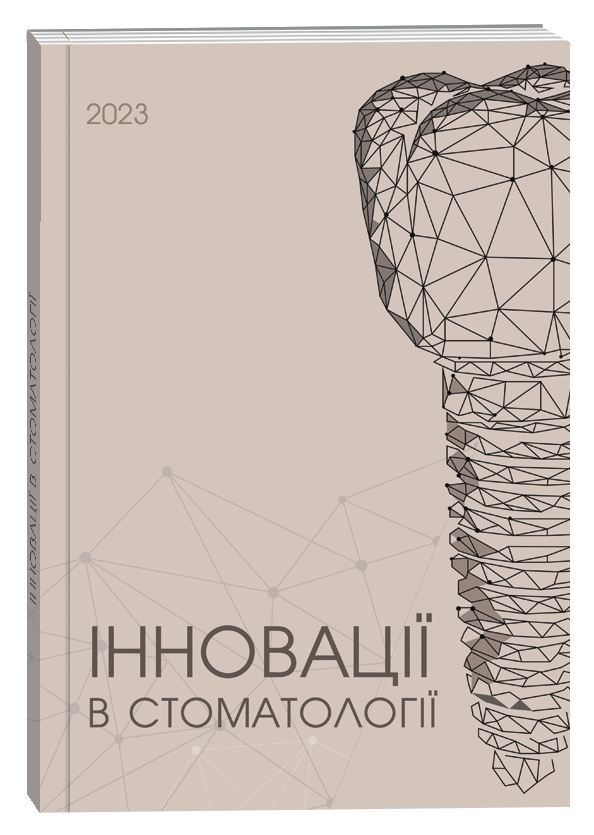CLINICAL AND LABORATORY JUSTIFICATION OF PREVENTION OF HEMODYNAMIC DISORDERS OF DENTAL PULP AFTER ODONTOPREPARATION
DOI:
https://doi.org/10.35220/2523-420X/2023.1.3Keywords:
prevention, bioflavonoids, minerals, hyaluronic acid, odontopreparation, rheodentographyAbstract
Purpose of the work. Assessment of the functional state of the pulp as a result of the use of a complex of hyaluronic acid, bioflavonoids and minerals to increase the effectiveness of preventing complications after odontopreparation under fixed orthopedic structures. Materials and methods of research. The total number of patients examined for the clinical part of the study was 80 people, who were divided into two groups: Group I: Main – 40 patients who used our proposed therapeutic and preventive complex with the use of gel “Querthial” zinc oxide powder, HYDROCAL (calcium hydroxide powder) Cerkamed, Poland to fix temporary fixed dentures. The preparations are mixed ex tempore, in equal proportions, until a homogeneous paste is obtained. The finished paste was used to treat the exposed surface of dentin and fix temporary crowns. Group II: comparison – 40 patients who used traditional fixing materials to fix temporary fixed dentures. A total of 234 teeth were prepared for cast, metal composite and cermet crowns. Research results and their discussion. The average level of the geographical index before odontopreparation was within the standard values, the same in the comparison groups and amounted to 17.2 (95% CI 17.13 – 17.27) Ohms among all respondents. The article presents the results of a study of the functional state of the pulp after odontopreparation for fixed orthopedic structures. An analysis of pulp hemodynamics was carried out, as a result of which it was proved that the use of the proposed complex significantly reduces inflammatory reactions in the tooth pulp, increases its resistance after odontopreparation. Conclusions. The proposed therapeutic and preventive material had a stimulating effect on the pulp vessels, which is objectively confirmed by a faster recovery of RI, di and wild indicators to the level of standard values.
References
Shillinburg, G.T. (2011). Basics of non-removable prosthetics
Albers H.F. (2006). Dentine and sensitivity. Adept. Report. V.4. P.10-11.
Cury, J.A., Simxes, G.S., Del Bel Cury, A.A., & Goncalves, N.C. (2005). Effect of calcium carbonatebased dentifrice on in situ enamel remineralization. Caries Res. V.39. P.255-257.
Hutchens, S.A., Benson, R.S., Evan,s B.R., O'Neill, H.M., & Raun, C.J. (2006). Biomimetic synthesis of calcium-deficient hydroxyapatite in a natural hydrogel. Biomaterials. V.26. P.4661-4670.
Kielbassa, A.M., Helwig, E., & Meyer-Lueckel, H. (2006). Effects of irradiation on in situ remineralization of human and bovine enamel demineralized in vitro. Quintessenz. V.40. P.130-135.
Lynch, R.J.M., & ten Cate, J.M. (2006). Effect of calcium glycerophosphate on demineralization in an in vitro biofilm model. Caries Res. V. 40. P. 142-147.
Tagliaferro, E.P.S., Rodrigues, L.K.A., Nobre dos Santos, M., Soares, L.E.S., & Martin, A.A. (2007). Combined effects of carbon dioxide laser and fluoride on demineralized primary enamel: an in vitro study. Caries Res. V. 41. P. 74-76.
Trope, M., McDougal, R., & Levin, L. et al. (2002). Capping the inflamed pulp under different clinical conditions. J Esthet Restor Dent. № 14. P. 349-357.








